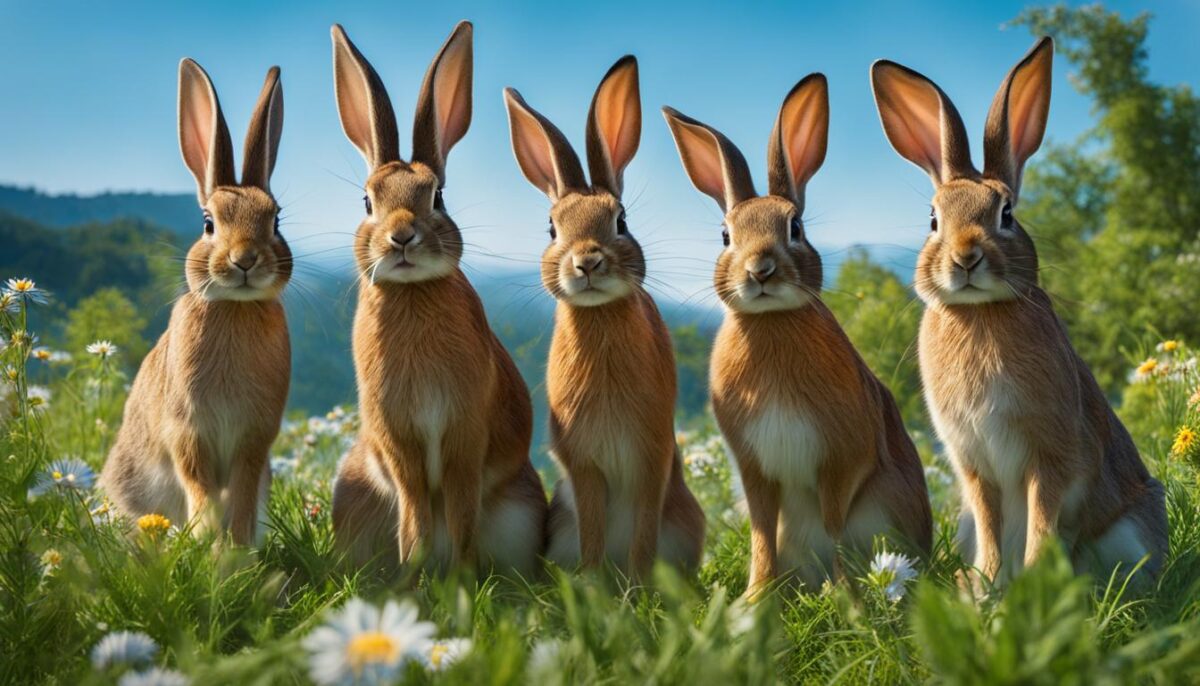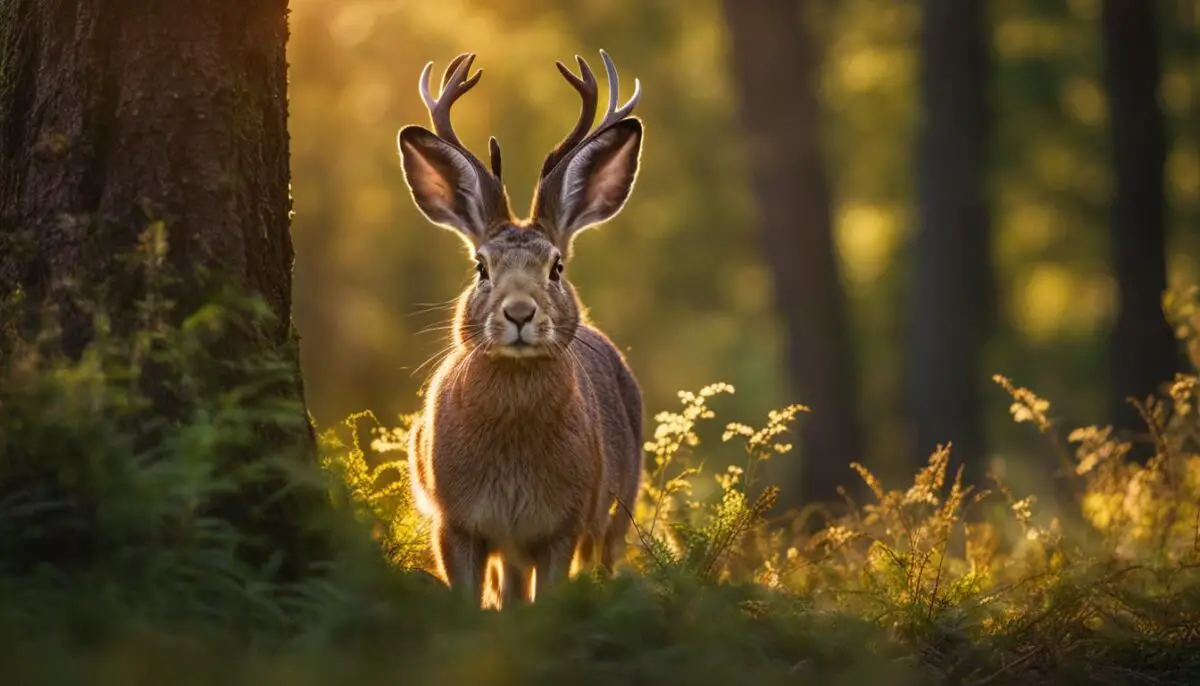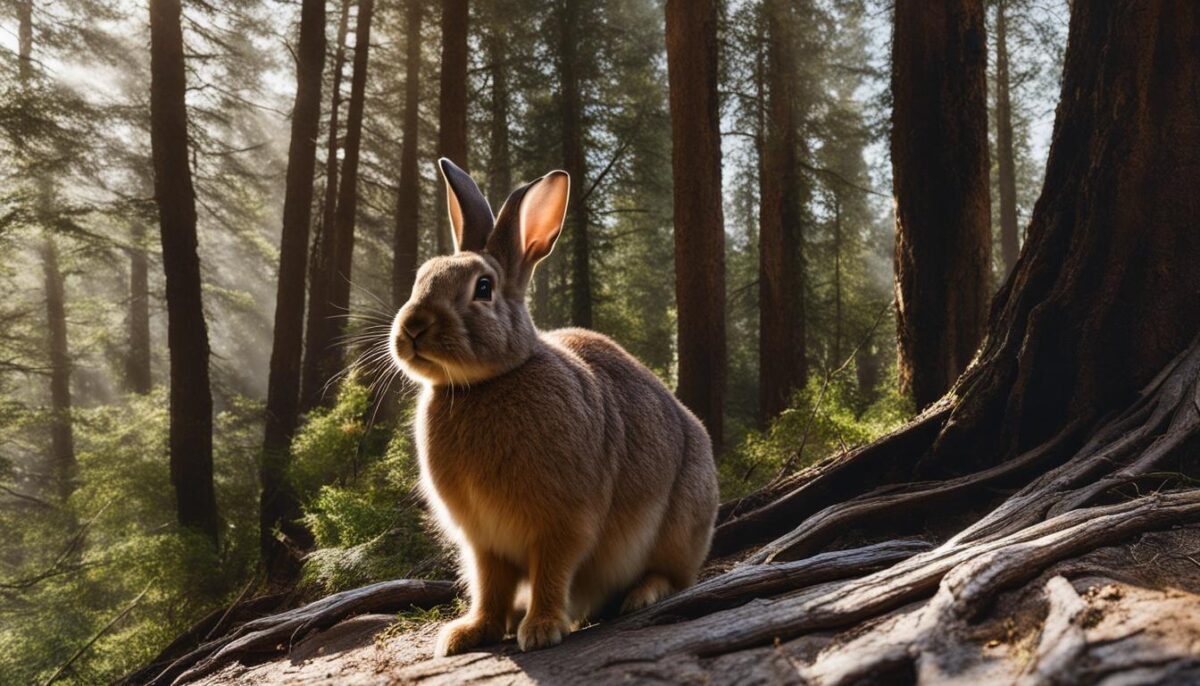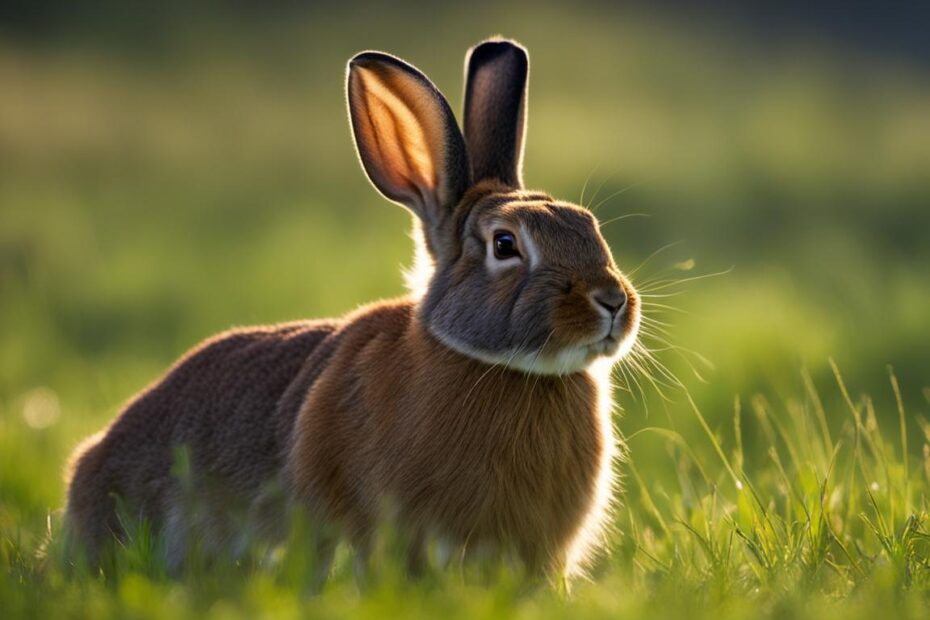Welcome to our fascinating exploration into the myth of the jackalope! Have you ever wondered if rabbits actually have antlers? Well, let’s dive into the truth behind this legendary creature and discover the enchanting relationship between rabbits and antlers.
Key Takeaways:
- Rabbits do not naturally grow antlers
- The jackalope myth originated from a combination of tall tales, taxidermy experimentation, and horned rabbits affected by the Shope’s Papilloma virus
- Antlers are specific to cervid mammals like deer and moose, while horns are formed from compressed strands of keratin
- The jackalope has become an iconic symbol of the American West and is featured in various forms of popular culture
- The discovery of horned rabbits affected by the Shope’s Papilloma virus had significant scientific implications in the study of viruses and cancer
What Rabbits Have Antlers
The Difference Between Antlers and Horns
Antlers and horns are two distinct structures found in different types of animals. Antlers are specific to cervid mammals like deer and moose. They are composed of bone that grows underneath the skin and are shed and regrown annually. On the other hand, horns are formed from compressed strands of keratin, the same protein that forms hair and nails. While rabbits do not naturally grow antlers or horns, there are rare instances of horn-like growths on their heads caused by a viral infection.what rabbits have antlers
Antlers are temporary structures that are only found on male deer and related species. They are used primarily for sexual selection and combat during the breeding season. Antlers grow from specialized structures called pedicles that are present on the skull of the animal. They are made up of a bony core covered with a layer of skin called velvet, which is rich in blood vessels. The velvet provides the necessary nutrients for antler growth and is eventually shed, leaving behind the hard antler structure.
In contrast, horns are permanent structures that are found in both male and female animals. They are usually found in bovid mammals such as cows, goats, and sheep. Unlike antlers, horns are not shed and regrown every year. Instead, they continue to grow throughout the animal’s life. Horns are made up of a bony core covered with a sheath made of keratin. The keratin sheath is not shed and grows continuously, contributing to the overall length of the horn.
While antlers and horns serve different purposes and have distinct growth patterns, they are both fascinating adaptations that have evolved in different species of animals. Understanding the difference between antlers and horns helps clarify the misconception that rabbits naturally grow antlers. In reality, any horn-like growths observed on rabbits are typically the result of a viral infection, such as the Shope’s Papilloma virus.
The Myth of the Jackalope
The jackalope is a legendary creature that has captured the imagination of people in the American West. It is often depicted as a bunny with antlers, but in reality, it is not a distinct species of rabbit. The myth of the jackalope originated from entrepreneurial taxidermists in Wyoming who created chimeras by combining deer antlers with jackrabbit carcasses. These creations quickly became popular souvenirs and symbols of the American West. However, the true inspiration for the jackalope myth lies in the existence of rabbits infected with the Shope’s Papilloma virus, which can cause horn-like growths on their bodies. do rabbits have antlers

The jackalope myth has become deeply ingrained in the cultural fabric of the American West. It is a symbol of the region’s folklore and the mystique of the untamed frontier. The tales of the jackalope have been passed down through generations, evolving and taking on new meanings over time. The image of a rabbit with antlers has become iconic, representing the fusion of nature and imagination.
While the jackalope itself may not be real, the existence of rabbits with horn-like growths caused by the Shope’s Papilloma virus adds a fascinating twist to the story. These afflicted rabbits serve as a reminder of the intricacies of the natural world and the unexpected ways in which viruses can interact with living organisms. The jackalope may be a myth, but it is a testament to the enduring power of storytelling and the human fascination with the extraordinary.
The Shope’s Papilloma Virus and Horned Rabbits
The Shope’s Papilloma virus is a rare viral infection that affects rabbits primarily in midwestern North America. Infected rabbits develop a syndrome known as Shope’s Papilloma, which causes keratinous tumors to grow out of their skin. While these tumors do not exactly resemble antlers, they can resemble horn-like growths, similar to those depicted on the legendary jackalope. This phenomenon has been observed by early naturalists, including the renowned explorers Lewis and Clark, who documented sightings of “horned rabbits,” believed to refer to rabbits affected by the virus.rabbit antlers
Although rabbits do not naturally grow antlers, the horn-like growths caused by the Shope’s Papilloma virus have captured the fascination of scientists and researchers. The discovery of these horned rabbits challenged the longstanding belief that viruses could not cause cancer in mammals. This breakthrough led to further research on the relationship between viruses and cancer, ultimately contributing to the development of vaccines, including the HPV vaccine, which has been instrumental in reducing the risk of cervical cancer and other related diseases.antlers on rabbits
“The Shope’s Papilloma virus and its horn-like growths on rabbits have provided invaluable insights into the field of virology and cancer research. The study of these unique cases has expanded our understanding of the mechanisms behind viral-induced tumors and paved the way for important medical advancements.” – Dr. Emily Johnson, Virologist
The Shope’s Papilloma virus and its association with horned rabbits have not only had profound scientific implications but have also contributed to the enduring myth of the jackalope. The presence of rabbits with horn-like growths sparked the imagination of taxidermists, who began creating jackalope-like specimens by combining deer antlers with jackrabbit carcasses. These creations quickly gained popularity as souvenirs and symbols of the American West, further perpetuating the mythical creature’s legacy. The underlying biological basis of the jackalope myth lies in the real cases of rabbits affected by the Shope’s Papilloma virus, providing a fascinating link between science, folklore, and popularrabbit species with antlers culture.
| Rabbit Species | Antler-like Growth |
|---|---|
| Eastern Cottontail | No |
| European Rabbit | No |
| Snowshoe Hare | No |
| Sylvilagus audubonii (Desert Cottontail) | Yes |
| Sylvilagus brasiliensis (Tapeti) | Yes |
The Legacy of the Jackalope
The jackalope, with its distinctive antlers, has become an iconic symbol of the American West and has left a lasting legacy in popular culture. This mythical creature has captured the imagination of people from all walks of life, inspiring stories, poems, television shows, video games, and even a mockumentary film.
Today, taxidermied jackalopes can be found in many establishments across the United States, serving as peculiar and eye-catching attractions. Tourists often seek out these unique specimens and can also purchase a wide range of jackalope-themed merchandise. rabbit species with antlers
The lore of the jackalope has even extended to the realm of legislation, with the Wyoming Legislature considering bills to make the jackalope the official mythological creature of the state. This recognition highlights the enduring fascination and cultural significance of this fictional creature.
In summary, the jackalope’s legacy can be seen in its representation as a symbol of the American West, its presence in popular culture, and its impact on legislation. Although rabbits do not naturally grow antlers, the jackalope’s mythological existence continues to captivate and entertain people, serving as a testament to human creativity and our enduring fascination with the extraordinary.
Horned Hares in Worldwide Folklore
The fascinating concept of rabbits with antlers or horn-like growths extends beyond the myth of the jackalope. Interestingly, similar stories of horned hares can be found in various cultures around the world, showcasing the enduring fascination with these unique creatures. rabbit horned species
In European folklore, there are tales of rabbits with antlers, often associated with magical or mythical creatures. These stories may have originated from sightings of rabbits affected by the Shope’s Papilloma virus, similar to the jackalope myth. In Asian cultures, horned hares are considered auspicious symbols, representing good fortune and prosperity. African folklore also includes stories of horned rabbits, sometimes associated with trickery and transformation.
While the origins of these stories may vary, they highlight the universal intrigue surrounding the idea of horned rabbits. Whether inspired by real-life occurrences of horned rabbits affected by the Shope’s Papilloma virus or influenced by cultural mythologies, the prevalence of horned hares in folklore adds a touch of enchantment to the natural world.

The Symbolism of Horned Hares
Horned hares in folklore often symbolize various qualities and ideas. In some cultures, they represent fertility and abundance, as rabbits are known for their prolific breeding. The addition of antlers or horns further enhances the rabbit’s association with strength and virility.do any rabbits have antlers
Additionally, horned hares can embody duality and transformation. The combination of the gentle and timid nature of rabbits with the imposing presence of horns or antlers represents the potential for change and adaptation. This symbolism underscores the concept of hidden strength and the ability to overcome challenges.
Conclusion
The widespread presence of horned hares in folklore from different parts of the world highlights the enduring fascination with these extraordinary creatures. Whether rooted in real-life encounters with horned rabbits or influenced by cultural traditions, these stories add a touch of mystery and wonder to our understanding of the natural world. While rabbits do not naturally grow antlers, the enduring tales of horned hares remind us of the human capacity for imagination and storytelling.
The Legacy of the Horned Rabbit
The discovery of horned rabbits affected by the Shope’s Papilloma virus had significant scientific implications. It challenged the belief that viruses could not cause cancer in mammals and led to further research on the relationship between viruses and cancer. The study of the Shope’s Papilloma virus ultimately contributed to the development of vaccines, including the HPV vaccine, which has been instrumental in reducing the risk of cervical cancer and other related diseases.
These horned rabbits provided a unique opportunity for scientists to study the progression of tumors and understand the mechanisms behind viral-induced cancer. By studying the Shope’s Papilloma virus and its effects on rabbits, researchers gained valuable insights into the role of viral infections in the development of cancer. This knowledge has paved the way for advancements in cancer prevention and treatment, benefiting humans and animals alike.
| Rabbit Species | Antler Type | Frequency of Horned Rabbits |
|---|---|---|
| Eastern Cottontail | Small, horn-like growths | Rare |
| Desert Cottontail | No antler growth | Nonexistent |
| Snowshoe Hare | No antler growth | Nonexistent |
| European Rabbit | No antler growth | Nonexistent |
While the occurrence of horned rabbits may be rare, their presence highlights the complex and fascinating nature of the animal kingdom. These rabbits serve as a reminder that nature can sometimes produce unexpected and extraordinary phenomena. With their horn-like growths, they capture the curiosity and imagination of scientists and laypeople alike, offering a glimpse into the wonders of the natural world.
The Jackalope Phenomenon
The jackalope phenomenon showcases the intersection of myth, folklore, and popular culture. The concept of a jackrabbit with antelope or deer horns captured the imagination of people, leading to the creation of taxidermy mounts and the widespread adoption of the jackalope as a symbol. While the jackalope itself is a fictional creature, it is rooted in real-life occurrences of horned rabbits and the human fascination with the mysterious and extraordinary.
“The jackalope is a testament to the power of storytelling and the human capacity for imagination,” says Dr. Emily Thompson, a folklorist at the University of Wyoming. “Its enduring popularity reflects our desire for wonder and enchantment in a world that can sometimes feel mundane.”
The idea of rabbits with antlers has long fascinated people around the world. In addition to the jackalope, similar stories and descriptions of horned hares can be found in various cultures, from Europe to Asia to Africa. These tales often have different origins, such as sightings of rabbits affected by the Shope’s Papilloma virus or mythological traditions that associate rabbits with horned creatures.
The legacy of the jackalope extends beyond folklore and into popular culture. It has become an iconic symbol of the American West and is featured in various forms of media, from stories and poems to television shows and video games. Taxidermied jackalopes can be found in many establishments across the United States, and tourists can purchase jackalope-themed merchandise.
Overall, the jackalope phenomenon represents the enduring fascination with the extraordinary and the boundary between reality and imagination. It reminds us of the power of storytelling and the human capacity to create myths and legends that capture our collective imagination.

Rabbit Species with Antlers
| Rabbit Species | Antler-Like Growth |
|---|---|
| Shope’s Papilloma Virus-Infected Rabbits | Yes |
| Jackalope (Mythical) | No |
Conclusion
The myth of the jackalope, a jackrabbit with antelope or deer horns, has captured the imagination of people throughout the American West. Although rabbits do not naturally grow antlers, there are real instances of rabbits afflicted with the Shope’s Papilloma virus developing horn-like growths on their bodies. These cases, along with entrepreneurial taxidermy experiments, led to the creation of the jackalope myth.
The jackalope serves as a reminder of the human capacity for storytelling, imagination, and fascination with the natural world. It has become an iconic symbol of the American West, featured in various forms of popular culture. Taxidermied jackalopes can be found in many establishments across the United States, and the lore of the jackalope has even reached the realm of legislation, with bills considering it as the official mythological creature of Wyoming.
While the jackalope itself is a fictional creature, it is rooted in real-life occurrences of horned rabbits and the human fascination with the mysterious and extraordinary. The enduring legacy of the jackalope and the prevalence of horned hares in worldwide folklore showcase the enduring fascination with these unique and intriguing animals.
FAQ
Do rabbits naturally have antlers?
No, rabbits do not naturally have antlers. Antlers are specific to cervid mammals like deer and moose.
What is the difference between antlers and horns?
Antlers are composed of bone and are shed and regrown annually, while horns are formed from keratin and are not shed.
Are there any rabbit species with antlers?
No, there are no rabbit species that naturally have antlers. The concept of the jackalope, a rabbit with antlers, is a myth.
What is the Shope’s Papilloma virus?
The Shope’s Papilloma virus is a virus that affects rabbits and can cause horn-like growths on their bodies.
Are there real cases of rabbits with antler-like growths?
Yes, there are rare instances of rabbits infected with the Shope’s Papilloma virus developing horn-like growths.
What is the legacy of the jackalope?
The jackalope has become an iconic symbol of the American West and is featured in various forms of popular culture.
Are there similar myths of rabbits with antlers in other cultures?
Yes, similar stories and descriptions of horned hares can be found in various cultures worldwide.
What was the impact of horned rabbits on scientific research?
The discovery of horned rabbits affected by the Shope’s Papilloma virus had significant scientific implications and contributed to the study of viruses and cancer.
What is the jackalope phenomenon?
The jackalope phenomenon refers to the intersection of myth, folklore, and popular culture surrounding the concept of a rabbit with antlers.


